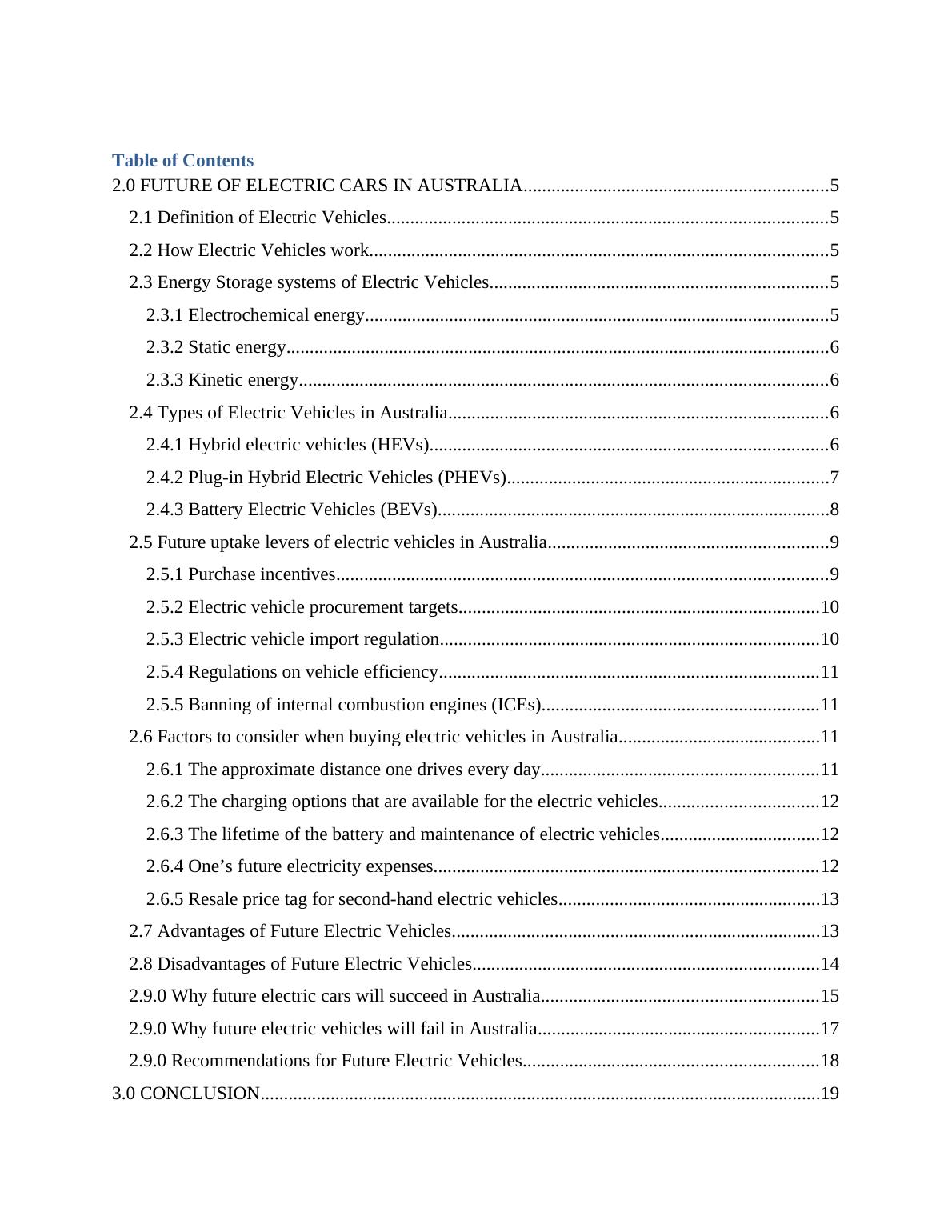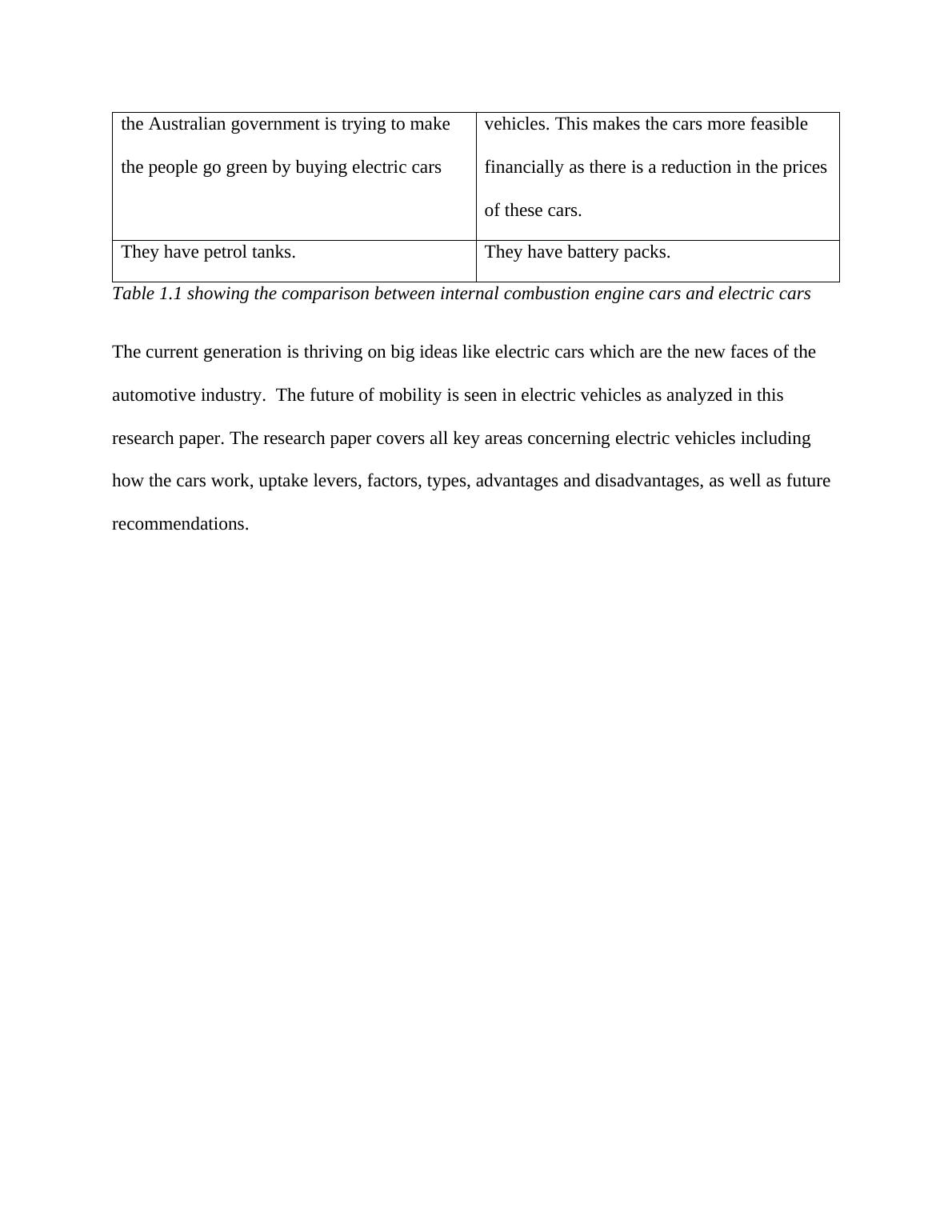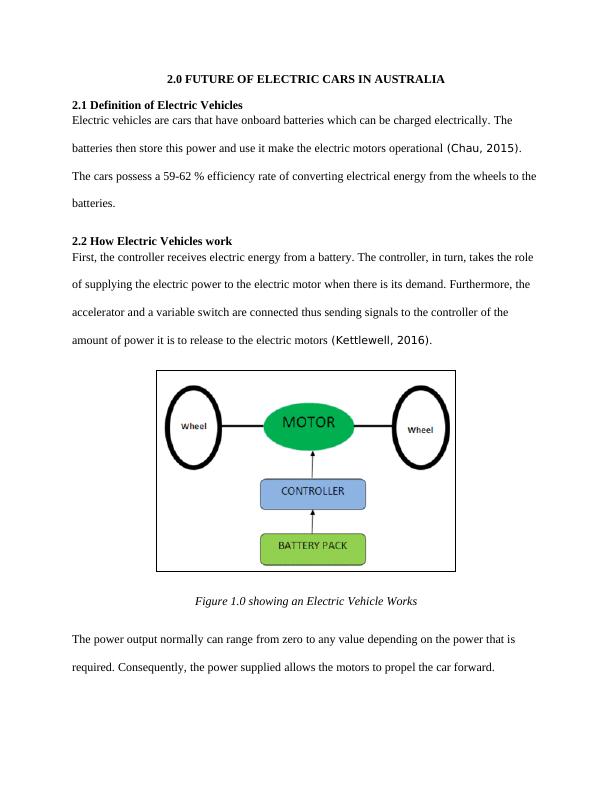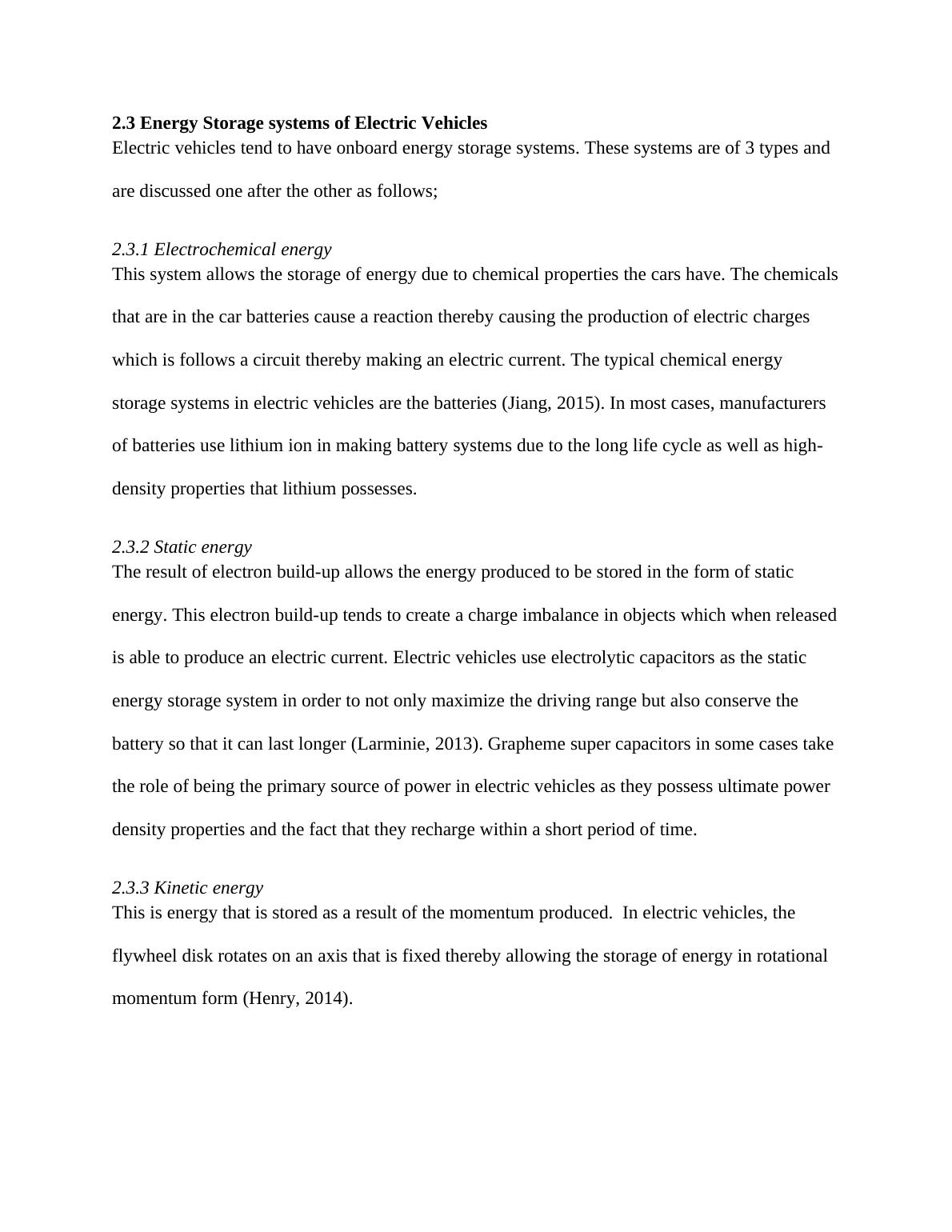The Future of Electric Vehicles in Australia
Added on 2022-11-28
22 Pages6162 Words319 Views
THE FUTURE OF ELECTRIC VEHICLES IN AUSTRALIA
By
Course
Instructor
Institution
Location
Date
By
Course
Instructor
Institution
Location
Date

Table of Contents
2.0 FUTURE OF ELECTRIC CARS IN AUSTRALIA.................................................................5
2.1 Definition of Electric Vehicles..............................................................................................5
2.2 How Electric Vehicles work..................................................................................................5
2.3 Energy Storage systems of Electric Vehicles........................................................................5
2.3.1 Electrochemical energy...................................................................................................5
2.3.2 Static energy....................................................................................................................6
2.3.3 Kinetic energy.................................................................................................................6
2.4 Types of Electric Vehicles in Australia.................................................................................6
2.4.1 Hybrid electric vehicles (HEVs).....................................................................................6
2.4.2 Plug-in Hybrid Electric Vehicles (PHEVs).....................................................................7
2.4.3 Battery Electric Vehicles (BEVs)....................................................................................8
2.5 Future uptake levers of electric vehicles in Australia............................................................9
2.5.1 Purchase incentives.........................................................................................................9
2.5.2 Electric vehicle procurement targets.............................................................................10
2.5.3 Electric vehicle import regulation.................................................................................10
2.5.4 Regulations on vehicle efficiency.................................................................................11
2.5.5 Banning of internal combustion engines (ICEs)...........................................................11
2.6 Factors to consider when buying electric vehicles in Australia...........................................11
2.6.1 The approximate distance one drives every day...........................................................11
2.6.2 The charging options that are available for the electric vehicles..................................12
2.6.3 The lifetime of the battery and maintenance of electric vehicles..................................12
2.6.4 One’s future electricity expenses..................................................................................12
2.6.5 Resale price tag for second-hand electric vehicles........................................................13
2.7 Advantages of Future Electric Vehicles...............................................................................13
2.8 Disadvantages of Future Electric Vehicles..........................................................................14
2.9.0 Why future electric cars will succeed in Australia...........................................................15
2.9.0 Why future electric vehicles will fail in Australia............................................................17
2.9.0 Recommendations for Future Electric Vehicles...............................................................18
3.0 CONCLUSION........................................................................................................................19
2.0 FUTURE OF ELECTRIC CARS IN AUSTRALIA.................................................................5
2.1 Definition of Electric Vehicles..............................................................................................5
2.2 How Electric Vehicles work..................................................................................................5
2.3 Energy Storage systems of Electric Vehicles........................................................................5
2.3.1 Electrochemical energy...................................................................................................5
2.3.2 Static energy....................................................................................................................6
2.3.3 Kinetic energy.................................................................................................................6
2.4 Types of Electric Vehicles in Australia.................................................................................6
2.4.1 Hybrid electric vehicles (HEVs).....................................................................................6
2.4.2 Plug-in Hybrid Electric Vehicles (PHEVs).....................................................................7
2.4.3 Battery Electric Vehicles (BEVs)....................................................................................8
2.5 Future uptake levers of electric vehicles in Australia............................................................9
2.5.1 Purchase incentives.........................................................................................................9
2.5.2 Electric vehicle procurement targets.............................................................................10
2.5.3 Electric vehicle import regulation.................................................................................10
2.5.4 Regulations on vehicle efficiency.................................................................................11
2.5.5 Banning of internal combustion engines (ICEs)...........................................................11
2.6 Factors to consider when buying electric vehicles in Australia...........................................11
2.6.1 The approximate distance one drives every day...........................................................11
2.6.2 The charging options that are available for the electric vehicles..................................12
2.6.3 The lifetime of the battery and maintenance of electric vehicles..................................12
2.6.4 One’s future electricity expenses..................................................................................12
2.6.5 Resale price tag for second-hand electric vehicles........................................................13
2.7 Advantages of Future Electric Vehicles...............................................................................13
2.8 Disadvantages of Future Electric Vehicles..........................................................................14
2.9.0 Why future electric cars will succeed in Australia...........................................................15
2.9.0 Why future electric vehicles will fail in Australia............................................................17
2.9.0 Recommendations for Future Electric Vehicles...............................................................18
3.0 CONCLUSION........................................................................................................................19

Works Cited...................................................................................................................................20
1.0 INTRODUCTION
Globally, 26 % of energy is used in the transport industry thereby creating greenhouse gas
emissions levels of 23 %. Currently, street traffic can be used to indicate 74 % of the global
transport sector which comprises of vehicles, trains, aircraft and ships. Automobiles play a vital
role in the automotive sector in most countries of the world. Cars are the dominant feature of
modern street traffics (Blum, 2017). In order to meet the requirements of future mobility, there
is a need to reduce greenhouse gas emissions using the technology available. This statement
implies that it is time to embrace advancements in the automotive industry that will lead to zero
or minimum emissions. People must, therefore, shift from internal combustion engines and
embrace new innovations.
Internal combustion engine vehicles Electric vehicles
They tend to be powered by gasoline which is
combusted internally to produce energy to run
the cars.
They run on electricity which is produced in
many ways including renewable energy
sources as well as fossil fuels.
They tend to create a lot of maintenance costs
more so depending on the age of the vehicle.
One needs to change the transmission fluid,
engine oil, as well as belts which is an extra
cost to the owners.
Electric cars are not fitted with internal
combustion engines as it derives its power
mainly from the batteries. The only expensive
bit of owning this car is the battery
replacement costs.
In most states in Australia, there is tax like
stamp duty that is applied to these vehicles as
In most states in Australia, there are
incentives and rebates when buying electric
1.0 INTRODUCTION
Globally, 26 % of energy is used in the transport industry thereby creating greenhouse gas
emissions levels of 23 %. Currently, street traffic can be used to indicate 74 % of the global
transport sector which comprises of vehicles, trains, aircraft and ships. Automobiles play a vital
role in the automotive sector in most countries of the world. Cars are the dominant feature of
modern street traffics (Blum, 2017). In order to meet the requirements of future mobility, there
is a need to reduce greenhouse gas emissions using the technology available. This statement
implies that it is time to embrace advancements in the automotive industry that will lead to zero
or minimum emissions. People must, therefore, shift from internal combustion engines and
embrace new innovations.
Internal combustion engine vehicles Electric vehicles
They tend to be powered by gasoline which is
combusted internally to produce energy to run
the cars.
They run on electricity which is produced in
many ways including renewable energy
sources as well as fossil fuels.
They tend to create a lot of maintenance costs
more so depending on the age of the vehicle.
One needs to change the transmission fluid,
engine oil, as well as belts which is an extra
cost to the owners.
Electric cars are not fitted with internal
combustion engines as it derives its power
mainly from the batteries. The only expensive
bit of owning this car is the battery
replacement costs.
In most states in Australia, there is tax like
stamp duty that is applied to these vehicles as
In most states in Australia, there are
incentives and rebates when buying electric

the Australian government is trying to make
the people go green by buying electric cars
vehicles. This makes the cars more feasible
financially as there is a reduction in the prices
of these cars.
They have petrol tanks. They have battery packs.
Table 1.1 showing the comparison between internal combustion engine cars and electric cars
The current generation is thriving on big ideas like electric cars which are the new faces of the
automotive industry. The future of mobility is seen in electric vehicles as analyzed in this
research paper. The research paper covers all key areas concerning electric vehicles including
how the cars work, uptake levers, factors, types, advantages and disadvantages, as well as future
recommendations.
the people go green by buying electric cars
vehicles. This makes the cars more feasible
financially as there is a reduction in the prices
of these cars.
They have petrol tanks. They have battery packs.
Table 1.1 showing the comparison between internal combustion engine cars and electric cars
The current generation is thriving on big ideas like electric cars which are the new faces of the
automotive industry. The future of mobility is seen in electric vehicles as analyzed in this
research paper. The research paper covers all key areas concerning electric vehicles including
how the cars work, uptake levers, factors, types, advantages and disadvantages, as well as future
recommendations.

2.0 FUTURE OF ELECTRIC CARS IN AUSTRALIA
2.1 Definition of Electric Vehicles
Electric vehicles are cars that have onboard batteries which can be charged electrically. The
batteries then store this power and use it make the electric motors operational (Chau, 2015).
The cars possess a 59-62 % efficiency rate of converting electrical energy from the wheels to the
batteries.
2.2 How Electric Vehicles work
First, the controller receives electric energy from a battery. The controller, in turn, takes the role
of supplying the electric power to the electric motor when there is its demand. Furthermore, the
accelerator and a variable switch are connected thus sending signals to the controller of the
amount of power it is to release to the electric motors (Kettlewell, 2016).
Figure 1.0 showing an Electric Vehicle Works
The power output normally can range from zero to any value depending on the power that is
required. Consequently, the power supplied allows the motors to propel the car forward.
2.1 Definition of Electric Vehicles
Electric vehicles are cars that have onboard batteries which can be charged electrically. The
batteries then store this power and use it make the electric motors operational (Chau, 2015).
The cars possess a 59-62 % efficiency rate of converting electrical energy from the wheels to the
batteries.
2.2 How Electric Vehicles work
First, the controller receives electric energy from a battery. The controller, in turn, takes the role
of supplying the electric power to the electric motor when there is its demand. Furthermore, the
accelerator and a variable switch are connected thus sending signals to the controller of the
amount of power it is to release to the electric motors (Kettlewell, 2016).
Figure 1.0 showing an Electric Vehicle Works
The power output normally can range from zero to any value depending on the power that is
required. Consequently, the power supplied allows the motors to propel the car forward.

2.3 Energy Storage systems of Electric Vehicles
Electric vehicles tend to have onboard energy storage systems. These systems are of 3 types and
are discussed one after the other as follows;
2.3.1 Electrochemical energy
This system allows the storage of energy due to chemical properties the cars have. The chemicals
that are in the car batteries cause a reaction thereby causing the production of electric charges
which is follows a circuit thereby making an electric current. The typical chemical energy
storage systems in electric vehicles are the batteries (Jiang, 2015). In most cases, manufacturers
of batteries use lithium ion in making battery systems due to the long life cycle as well as high-
density properties that lithium possesses.
2.3.2 Static energy
The result of electron build-up allows the energy produced to be stored in the form of static
energy. This electron build-up tends to create a charge imbalance in objects which when released
is able to produce an electric current. Electric vehicles use electrolytic capacitors as the static
energy storage system in order to not only maximize the driving range but also conserve the
battery so that it can last longer (Larminie, 2013). Grapheme super capacitors in some cases
take the role of being the primary source of power in electric vehicles as they possess ultimate
power density properties and the fact that they recharge within a short period of time.
2.3.3 Kinetic energy
This is energy that is stored as a result of the momentum produced. In electric vehicles, the
flywheel disk rotates on an axis that is fixed thereby allowing the storage of energy in rotational
momentum form (Henry, 2014).
Electric vehicles tend to have onboard energy storage systems. These systems are of 3 types and
are discussed one after the other as follows;
2.3.1 Electrochemical energy
This system allows the storage of energy due to chemical properties the cars have. The chemicals
that are in the car batteries cause a reaction thereby causing the production of electric charges
which is follows a circuit thereby making an electric current. The typical chemical energy
storage systems in electric vehicles are the batteries (Jiang, 2015). In most cases, manufacturers
of batteries use lithium ion in making battery systems due to the long life cycle as well as high-
density properties that lithium possesses.
2.3.2 Static energy
The result of electron build-up allows the energy produced to be stored in the form of static
energy. This electron build-up tends to create a charge imbalance in objects which when released
is able to produce an electric current. Electric vehicles use electrolytic capacitors as the static
energy storage system in order to not only maximize the driving range but also conserve the
battery so that it can last longer (Larminie, 2013). Grapheme super capacitors in some cases
take the role of being the primary source of power in electric vehicles as they possess ultimate
power density properties and the fact that they recharge within a short period of time.
2.3.3 Kinetic energy
This is energy that is stored as a result of the momentum produced. In electric vehicles, the
flywheel disk rotates on an axis that is fixed thereby allowing the storage of energy in rotational
momentum form (Henry, 2014).

End of preview
Want to access all the pages? Upload your documents or become a member.
Related Documents
Hybrid & Electric Vehicles: A Comprehensive Reportlg...
|17
|4302
|299
Aerodynamic Design Optimization of Solar-Powered Vehicles using CFDlg...
|11
|2078
|92
Electric Car: An Alternative Fuel Automobilelg...
|10
|650
|96
Solar Power Electric Cars: Future Trends and Importancelg...
|4
|788
|227
HEV Engine Optimization PDFlg...
|31
|5267
|17
Electric Vehicle vs. Gas Vehiclelg...
|8
|1488
|98
